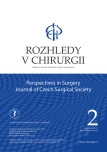Radiological analysis of the results of expandable implant insertion in one - to two-level cervical somatectomy
Authors:
K. Saur; M. Májovský; P. Vaněk
Authors‘ workplace:
Neurochirurgická a neuroonkologická klinika 1. lékařská fakulty Univerzity Karlovy a Ústřední vojenská nemocnice – Vojenská fakultní nemocnice Praha
Published in:
Rozhl. Chir., 2020, roč. 99, č. 2, s. 72-76.
Category:
Original articles
Overview
Introduction: The aim of the study was to radiologically analyse the results of expandable implant insertion in one - to two-level cervical spine somatectomy.
Methods: A total of 28 patients undergoing one - to two-level somatectomy in cervical spine were postoperatively examined by CT. The following radiological parameters were studied: Cobb angle C2-7, segmental Cobb angle, implant subsidence and bone fusion.
Results: The average Cobb angle of C2-7 in preoperative images was 13.7 degrees, 13.4 degrees in the early postoperative period (p=0.88), and 10.3 degrees (p=0.043) 2 years after the surgery. The average segmental Cobb angle in preoperative images was 4.4 degrees, 5.2 degrees in the early postoperative period (p=0.61), and 0.2 degrees (p=0.01) 2 years after the surgery. Significant implant subsidence was observed in 15 cases (53.6%).
Grade I fusion was achieved in 6 cases (21.4%), grade II fusion in 12 cases (42.9%), and stable pseudoarthrosis (grade III) in 9 cases (32.1%). No cases of unstable pseudoarthrosis (grade IV) were detected.
Conclusion: Implantation of an expandable vertebral body implant in one - to two-level cervical spine somatectomy with ventral plate fixation is a fully acceptable way to reconstruct the ventral column of the cervical spine, providing sufficient long-term stability of the cervical spine and instrumentation and an adequate cervical spine curve.
Keywords:
expandable cage – corpectomy – cervical spine – subsidence – spinal fusion
Sources
- Arts MP, Peul WC. Vertebral body replacement systems with expandable cages in the treatment of various spinal pathologies: A prospectively followed case series of 60 patients. Neurosurgery 2008;63(3):537−545. doi:10.1227/01.neu.0000325260.00628.dc.
- Elder BD, Lo S-F, Kosztowski TA, et al. A systematic review of the use of expandable cages in the cervical spine. Neurosurgical Review 2015;39(1):1−11. doi:10.1007/s10143-015-0649-8.
- Payer M. Implantation of a distractible titanium cage after cervical corpectomy: technical experience in 20 consecutive cases. Acta Neurochirurgica 2006;148(11):1173−1180. doi:10.1007/s00701-006-0871-9.
- Waschke A, Kaczor S, Walter J, et al. Expandable titanium cages for anterior column cervical reconstruction and their effect on sagittal profile: a review of 48 cases. Acta Neurochirurgica 2013;155(5):801−807. doi:10.1007/s00701-013-1655-7.
- Cobb JR. Outline for tne study of scoliosis. Instructional course lectures. Am Acad Orthop Surg. 1948;5 : 261.
- Schulz C, Mauer U, Mathieu R. Implantatassoziierte Komplikationen sowie klinischer und radiologischer Verlauf nach anteriorer zervikaler Korpektomie und Cage-Fusion – retrospektiver Vergleich von PEEK - gegen Titan-Cages. Zeitschrift für Orthopädie und Unfallchirurgie 2017;155(02):201−208. doi:10.1055/s-0042-118717.
- Vavruch L, Hedlund R, Javid D, et al. A prospective randomized comparison between the cloward procedure and a carbon fiber cage in the cervical spine. Spine 2002;27(16):1694−1701. doi:10.1097/00007632-200208150-00003.
- Schnee CL, Freese A, Weil RJ, et al. Analysis of harvest morbidity and radiographic outcome using autograft for anterior cervical fusion. Spine 1997;22 : 2222−2227.
- Auguste KI, Chin C, Acosta FL, et al. Expandable cylindrical cages in the cervical spine: a review of 22 cases. Journal of Neurosurgery Spine 2006;4(4):285−291. doi:10.3171/spi.2006.4.4.285.
- Seaman S, Kerezoudis P, Bydon M, et al. Titanium vs. polyetheretherketone (PEEK) interbody fusion: Meta-analysis and review of the literature. Journal of Clinical Neuroscience 2017;44 : 23−29. doi:10.1016/j.jocn.2017.06.062.
- Gercek E, Arlet V, Delisle J, et al. Subsidence of stand-alone cervical cages in anterior interbody fusion: warning. European Spine Journal 2003;12(5):513−516. doi:10.1007/s00586-003-0539-6.
- Wu W-J, Jiang L-S, Liang Y, et al. Cage subsidence does not, but cervical lordosis improvement does affect the long-term results of anterior cervical fusion with stand-alone cage for degenerative cervical disc disease: a retrospective study. European Spine Journal 2011;21(7):1374−1382. doi:10.1007/s00586-011-2131-9.
Labels
Surgery Orthopaedics Trauma surgeryArticle was published in
Perspectives in Surgery

2020 Issue 2
Most read in this issue
- Maisonneuve fracture
- Sagittal profile of cervical and whole spine before and after surgery of subaxial cervical spine
- Solitary fibrous tumor of the pleura as a rare cause of severe hypoglycemia: Doege-Potter syndrome
- Benign liver angiomyolipoma: a case study
